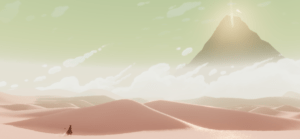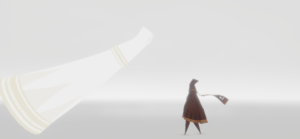This week I played Journey which was released in 2012. The game was developed by Thatgamecompany, published by Sony Computer Entertainment, and directed by Jenova Chen. It is an online game that can be played solo or with a team on PS3, PS4, PS5, PC, and iOS devices. I was not sure who the exact target audience for Journey is, but I’m guessing it includes an audience that appreciates discovery, visual design, mystery, exploring environments, and more. I played this game solo on an iPhone.
How does walking tell the story?
This was my first time every playing a walking simulator, so I had no idea what to expect. At first, I was confused by the lack of instruction or direction the game provided. However, when first starting a new journey, the only option was to walk. From the beginning, walking was portraying and developing the story. Journey used walking and other movements to control the illusion of time, develop companionship, and create opportunities for world exploration.
In Journey, the recognition of time was created by the pace or speed of movement. The music further supported this, eliciting greater emotions from the player. When I first entered the game, I took multiple 360 turns trying to understand what to do. Far off in the distance, there was one structure that differed from the endless sand. Even though it seemed incredibly far away, it created a lot of space in the environment, slowing down time as my player trudged through the sand towards the first structure. The entire walk over was building narrative tension since my curiosity was heightened because I had to wait and almost earn those answers. The longer walks creates more opportunities for players to fully explore and digest the artistic elements in the world.
 An example of the only nearby structure being incredibly far away. This was taken from later in my play, but represents a similar setting.
An example of the only nearby structure being incredibly far away. This was taken from later in my play, but represents a similar setting.
A similar concept was demonstrated when walking uphill vs downhill. Hiking up each sand hill was far slower, the music was slower sometimes listening to the rustling of the sand and wind. At times, the screen would also get darker as less light was reaching lower in the valleys. All of these were representative of how it would actually feel to walk up a mountain, which can sometimes feel more boring. On the other hand, going down the sand slopes felt incredible. The music would change to be more uplifting, the sand was sparkling, and it felt freeing – almost as if I were skiing down a mountain. It created an illusion of peace and beauty in the environment. The pace of movement was much faster and thrilling adding to this mood. The ability to fly created the same sense of excitement and opportunities for storytelling. The increased pace created senses of accomplishment changing how the player interacted with space around them.
 When walking automatically transitioned into flying, the change in movement dramatically affected the narrative and storytelling as I crossed the multiple flying bridges.
When walking automatically transitioned into flying, the change in movement dramatically affected the narrative and storytelling as I crossed the multiple flying bridges.
While walking, I found companionship through reciprocity in unexpected ways throughout the game. Specifically, I developed a sense of trust in the square-jellyfish looking creatures that became magical flying carpets! It was always impossible to fully understand the entire environment from where player is at any point. There are always hidden structures or towns above/below different sand mountains waiting to be discovered. At times, being at the bottom of a slope meant I could not see the town in the alley beyond the top of the slope. The first time the square-jellyfish looking beings appeared, they started to lead me towards the top of a slope. I was confused by their purpose/function and it was an incredibly steep slope. The whole slow way up, I was debating whether it was worth following them or if I had just spent the past 20 seconds trudging up the taller mountain for no reason. However, when I reached the top, I saw a beautiful town below me and could glide there in under a few seconds. It felt incredible. I had more space to explore around me, but the time I spent walking to earn that final exploration, made the whole process more worthwhile. That was when I began fully trusting the square-jellyfish creatures, creating friendship through walking and exploration of the world.
 Building a relationship with the square-jellyfish creatures, following their leads, and eventually finding a level of trust where I am able to fly alongside them.
Building a relationship with the square-jellyfish creatures, following their leads, and eventually finding a level of trust where I am able to fly alongside them.
Another mechanic I was not able to understand was how the artistic aesthetic would change as levels were completed. Players would enter this alternate world where the storyline was developed including additional characters. Throughout this, light was used as a symbol to guide players towards the next levels and finding a sense of progress, as well as in these storyline progressions with a primarily white background.





